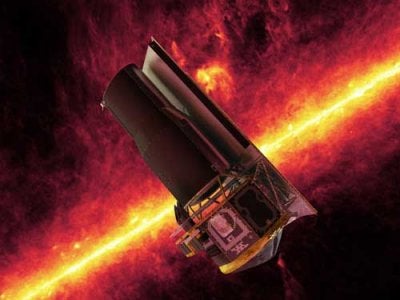At 1:35 a.m. EDT on Monday, August 25, the last member of NASA’s Great Observatories program lifted off of the ground at Cape Canaveral, Florida, and rocketed into the sky. The Space Infrared Telescope Facility (SIRTF) is now making its way toward its post in an Earth-trailing, heliocentric orbit where it will peer into the universe and explore where our eyes and even the Hubble Space Telescope cannot see.
“The Space Infrared Telescope Facility will detect objects that have been too cold, too hidden in dust, or too far away to be seen by other space observatories,” says Michael Werner, the mission’s project scientist at NASA’s Jet Propulsion Laboratory.
Each of NASA’s Great Observatories investigates a particular band of the electromagnetic spectrum. The Hubble Space Telescope was the first one to launch (in April 1990), and it observes at visible wavelengths. The second spacecraft, the Compton Gamma-ray Observatory, has already completed its mission and has been de-orbited. The third, the Chandra X-ray Observatory, was launched in 1999. Now, SIRTF will fill the gap by targeting the infrared universe.
Because SIRTF’s goal is to detect heat given off by faraway objects, it must remove interference from nearby sources such as its own instruments and our planet. The spacecraft will keep its “back” toward us as it follows Earth around the sun. Its equipment will be cooled by liquid hydrogen and the cold of space, while the power-generating solar panels will double as heat shields.
SIRTF will begin regular observations in about three months. Before then, as the spacecraft journeys to its station in space, ground controllers will conduct a two-month check-out period to test the telescope, instruments, and machinery while bringing SIRTF fully online. Then, during a 30-day science verification stage, mission scientists will conduct “dry runs” and make the first observations with SIRTF’s 33.5-inch (85-centimeter) telescope and its three instruments: the Infrared Array Camera, Infrared Spectrograph, and Multiband Imaging Photometer.
NASA intends to rename the spacecraft and will reveal the new title in the coming months. The mission is scheduled to last between 2.5 and 5 years.










